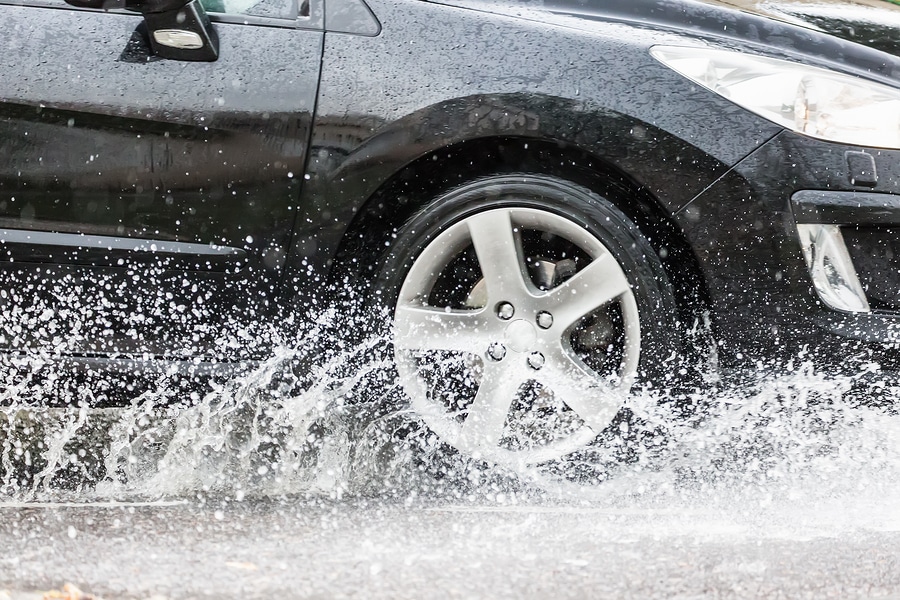
Most drivers know about the potential dangers of driving in the rain. Hydroplaning is a common problem in wet conditions and can affect all types of vehicles. Approximately 700,000 auto accidents occur in the United States each year. Issues occur when the vehicle’s tires are unable to maintain full contact with the road, and can pose serious safety hazards. Read on for more about identifying rain hazards and how to avoid them.
Hydroplaning
Ultimately, hydroplaning happens when the vehicle’s tires lose all traction due to water on the road. Rain can mix with oil residue on the surface of the road and create slippery conditions. Hydroplaning usually occurs when the vehicle is traveling at speeds over 35 mph. The tires lift away from the road, and it becomes difficult to control the car.
In the event of a hydroplane, it’s important that you don’t brake or turn suddenly, as it could throw your car into a skid. Hold the wheel as firmly as you can and don’t steer in any direction other than straight ahead. Slowly take your foot off the gas until the car slows and your steering becomes normal again. If you need to brake, do it gently and with a pumping action. If you have anti-lock brakes, you should be able to brake normally.
Tire features that affect the possibility of hydroplaning include:
- Tread pressure
- Tread depth
- Tread pattern
Tire Pressure
Tires hydroplane when the pressure of the tire pushing against the ground is equal to the water pushing back up against it. This occurs when a layer of water builds between the wheels and the surface of the road, especially during heavy or prolonged precipitation. When traction is lost, the vehicle cannot respond to control inputs nearly as efficiently as it usually can.
Most cars come with the manufacturer’s recommendation regarding tire pressure affixed to the driver’s door or door jamb or in the owner’s manual. While it’s always important to check your tire pressure at least once per month, it’s especially critical when you know you’re going to be driving in the rain. Keep your tires properly inflated and try to drive slow in hazardous conditions.
Tread Depth
A 2018 study from the Automobile Association of America provided new information about the dangers of older tires on wet roads. Through testing, they determined that driving in the rain or on wet roads on tires with only 4/32 in. of tread depth increased the stopping distance by up to 87 feet. The driver’s ability to control the vehicle was also reduced by 33%. The test also showed that vehicles braking at 60 mph with worn tires were still traveling at 40 mph when they reader the point where vehicles with new tires had stopped.
All-season tires are considered worn at 2/32 in., and generally start out between 10/32 in. and 11/32 in. of tread. As tires wear, their ability to handle wet braking and resist hydroplaning declines drastically. If you suspect your tires might be worn, it’s important to visit an auto repair shop and have a technician take a look. Driving on worn tires in an unnecessary risk, especially when it comes to rainy or wet conditions.
Tread Pattern
A tire’s tread is the part that makes contact with the surface of the road. The design is made up of the following five elements:
- Tread blocks
- Grooves
- Sipes
- Ribs
- Cross slots
Different tires have different tread patterns, which affect their performance. Some tread patterns can handle traction more efficiently. When it comes to handling wet roads and rainy conditions, asymmetric and directional tread patterns are ideal.
Asymmetric tread-patterned tires are designed with different channels and tread blocks in order to enhance performance. This design makes it easier for the tire to disperse water and improves grip. The outer side features tread blocks, which provide a large contact area for increased stability. The inner edge has channels, which direct water away for improved traction.
Directional tread-patterned tires are often made for winter and high-performance. The design is intended to help water move from under the contact patch to boost hydroplane resistance at higher speeds.
Avoiding Hydroplaning
Ultimately, it’s relatively easy to keep your tires from hydroplaning. The risk isn’t only there during a rainstorm or snowfall – the slick conditions left behind can be even more hazardous. However, the most dangerous period is generally the first 10 minutes of light rain. If you need to drive in the rain, make sure to:
- Keep your tires inflated
- Drive in a low gear
- Avoid sudden or hard braking
- Replace and rotate tires often
- Stay in the middle of the road
- Avoid standing or running water
- Turn off cruise control
- Drive slowly
- Do not make sharp turns
- Leave lots of room between yourself and the next car
- Aim for the tire tracks in front of you
- Look far up the road in front of your car
- Regularly visit an auto repair center to ensure your vehicle and tires are in good condition
Contact Hollenshade’s
In Maryland, every season is rain season. With unpredictable Mid-Atlantic weather patterns, it’s important to keep your tires inflated and well-functioning all year long. Contact Hollenshade’s at 410-983-3423 to make an appointment and have a Towson auto repair expert ensure your car is in the best condition possible.
